
Tortugas offer history, stunning scenery
DRY TORTUGAS, Fla.— About a century and a half ago, Florida’s paradisaical Dry Tortugas National Park was a dumping ground for murderers, confederate soldiers, rapists and other criminals.
But since one of its islands became a national monument in the 1930s, the Caribbean island cluster has been a tourist hot spot, attracting the likes of President Harry Truman, Ernest Hemingway, Queen Elizabeth II, Renee Russo and National Geographic researchers.
The Dry Tortugas, a remote seven-island chain that lies about 70 miles west of Key West, are one of Florida’s most beautiful destinations. Their clear-blue waters, marine diversity, unique wildlife and solace lure snorkelers, divers, birdwatchers and other nature-lovers from all over the world.
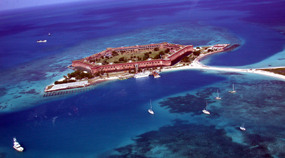 |
Visitors arriving by air are given this view of Fort Jefferson (Staff photos). |
Up to 94,000 people visit each year. The park is about 100 square miles in size. The islands are made of coral and sand. The tiny landmasses are Garden Key, Bush Key, Middle Key, Loggerhead Key, East Key, Long and Hospital Key. Garden Key, the largest of them all and the only habited island, is home to Fort Jefferson, the largest 19th century fortress in the coastal United States.
The 16-million brick citadel has a lighthouse, a moat, about a half-dozen iron cannons, and iron and wooden carts. Outdoor enthusiasts can stay overnight at the 10-tent rudimentary campsite with barbecue grills. Garden Key does not have running water, bathing facilities or concession stands. Visitors must carry their trash off the island.
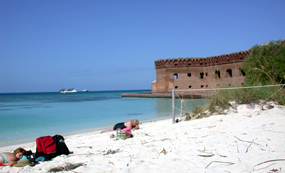 |
Fort Jefferson’s pristine beach offers diving and camping sites. |
The aquamarine waters surrounding the Tortugas are home to a rich underwater ecosystem that includes sharks, sea anemones, tarpons, coral reefs, and some dolphins.
Two shipwrecks lie off the coasts of the keys.
Gulls, sooty terns, brown pelicans, and the blackpoll warbler are some of the native and migratory birds that spend their winters on the Tortugas. Bush Key, which lies east of Garden Key, is the world’s nesting center for the sooty tern, a black-and white bird native to the Caribbean Sea and the west and central regions of the Atlantic Ocean.
About 100,000 flock to the key between March and September to lay their eggs. The Tortugas are also the nesting grounds for several endangered sea turtles, including the loggerhead and green species.
The Tortugas are not accessible by land. Visitors must take ferries, sailboats, fishing boats or seaplanes from Key West to Garden Key. The flight from Key West is breathtaking.
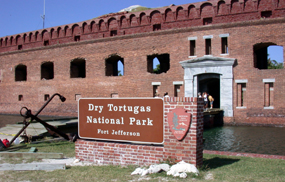 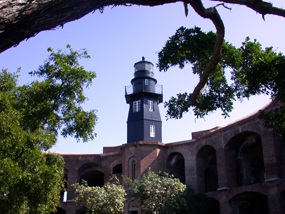 |
The entrance with the official park sign and fort lighthouse. |
Passengers can spot shipwrecks, sharks, dolphins, stingrays and loggerhead turtles as the Cessna seaplanes fly over the Marquesas Keys. The sunken Spanish galleons the Atocha and the Margarita are visible from the low-flying planes. Occasionally pilots have spotted marijuana bails and Cuban refugees, said John Wagner, a pilot with Seaplanes of Key West. Migrant smugglers will sometimes drop them off at the Marquesa Keys.
“I absolutely loved it,” said Fort Myers resident Linda Adams, who flew to the Tortugas. “The history,…the scenery—…it’s absolutely stunning.”
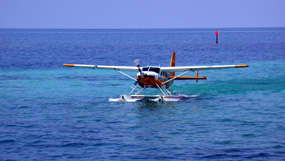 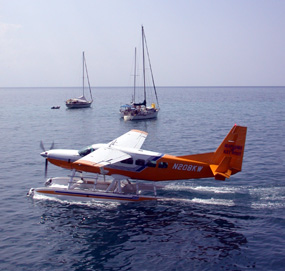 |
A seaplane taxis after landing at Fort Jefferson. |
“It was wonderful,”” said Coreda Walker, who was visiting Adams from Pennsylvania. “It was more than I thought it would be.” Coreda Walker said it was the first time she had visited the Tortugas and the first time she had snorkeled.
For Tom Walker, Coreda Walker’s husband, the seaplane ride was one the highlights of the trip.
“It [the trip] was spectacular,” Walker said. “That was the driving force … the seaplane ride,” he said. “It was the thing I wanted to do the most.”
Spanish explorer Juan Ponce de Leon discovered the keys in 1513 and named them Las Tortugas (the turtles) because of the sea turtle population living on them. The islands, dry, barren and devoid of water, were part of the Spanish crown until the Spaniards sold the territory to the United States in 1819. Florida became a state in 1845.
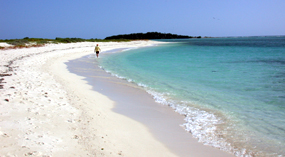 |
| Beaches are ideal for a stroll. |
The first structure built on the islands was the lighthouse on Garden Key, which dates back to 1826.
The U.S. government began constructing Fort Jefferson on Garden Key in 1846 to protect the commercial ships traveling through the Florida Straits from the Mississippi River to the eastern coast of the United States.
Lack of funds and an outbreak of yellow fever halted construction for a few years in the mid-1800s. Much of the construction was the work of slave labor.
The first garrison of soldiers arrived in 1861. During the Civil War, Fort Jefferson became the only Union fort in the southern United States. Between 600 and 1,200 soldiers lived at the fort during the war.
  |
Seaplanes park on the breach at Fort Jefferson. |
Its most famous inmate was Samuel A. Mudd, a Maryland doctor charged with conspiracy to kill President Abraham Lincoln. Mudd, jailed from July of 1865 to March of 1869, was pardoned in February of 1869 by President Andrew Johnson. The construction of the garrison continued until the 1870s, but was never finished.
After weathering several yellow fever epidemics, the army abandoned the citadel in 1873. Between the late 1800s and its designation as a national monument in 1935, the Fort Jefferson was used as a quarantine station for small pox and cholera, a research laboratory, and a Naval station during the Spanish-American War.
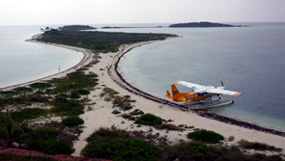 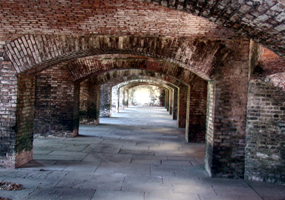 |
Scenes at Fort Jefferson. |
In 1935, President Franklin D. Roosevelt decreed Fort Jefferson a national monument. Since 1960, when the government formally drew the park limits, the boundaries have changed to protect marine life. The area was elevated to national park status in 1992.
The park is open year-round from 7 a.m. to dusk. Visitors can take free guided or self-guided tours around the fort and inside the lighthouse. The visitor’s center sells books maps, books, postcards, film, disposable cameras and other collectible items. The camping fee is $3 per person per night.
If You Go
Dry Tortugas National Park is about 70 miles west of Key West, Telephone: 305-293-0152
HOW TO GET THERE
Seaplanes of Key West, 3471 S. Roosevelt Blvd., in Key West, 305-294-0709, http://www.seaplanesofkeywest.com
Four-hour one-day round trip: Adults: $179, children ages 7-12: $129, children ages 6-2: $99, children under 2: free
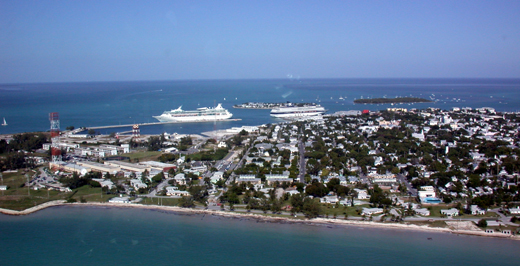 |
| A view of the port of Key West and Fort Zachary Taylor on the way to the Dry Tortugas. |
Eight-hour one-day trip: Adult: $305, children ages 7-12: $225, children 6-2: $170, children under 2: free
Overnight trip: Adult: $329, children 7-12: $235, children 6-2: $179, children under 2: free
Fare includes complimentary beverages and snorkel gear. Sales tax is not applicable. Reservations should be made at least 24 hours in advance.
Flight schedule: Planes fly out about three times a day, at 8 a.m., 10 a.m. and noon. Times may vary. The plane ride to the Tortugas is about 45 minutes each way.
Dry Tortugas and Fort Jefferson Yankee Freedom Ferry Service, 240 Margaret St., Key West, 800-634-0939, http://www.yankeefreedom.com
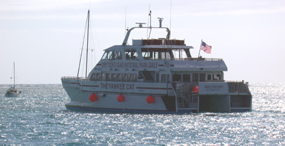 |
| The Yankee Freedom sails near Fort Jefferson. |
Day trip: Adult: $109, children ages 4-16: $69, student discount fare: $99, senior discount fare: $99, military personnel fare: $99
Overnight camping trip: Adult: $130, children 4-16: $99
Fares include snorkel gear, a continental breakfast, lunch and a tour of the fort. Sales tax is not applicable to fares. Kayaks are available for the trip. The rental cost is about $40. The ship leaves daily at 8 a.m.

Comments are Closed